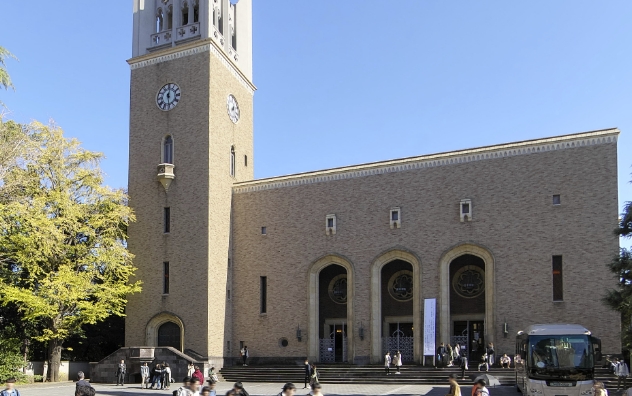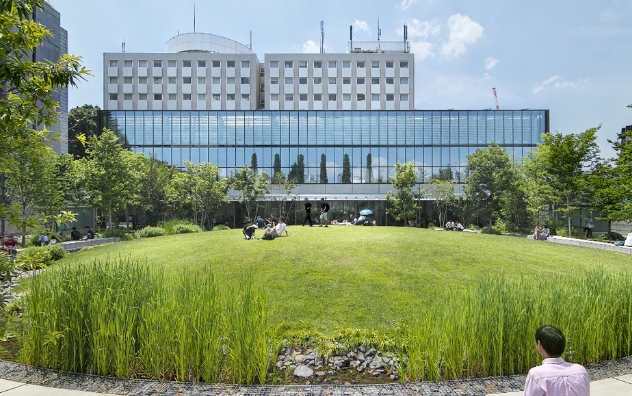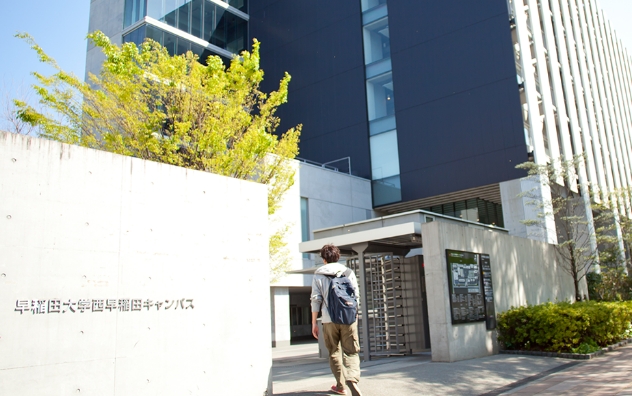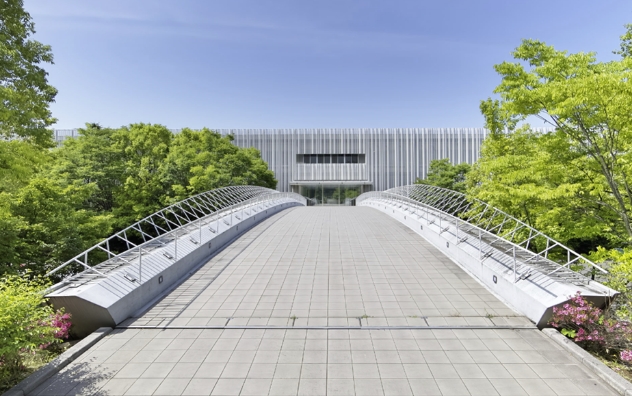127 Students and Teachers Volunteer Supported the Reconstruction Events in Natori and Kesennuma
Thu, Apr 5, 2012March 11th marked the one year anniversary since the Great East Japan Earthquake struck. On this day, together with prayers for the happiness in the next world of the victims of the disaster, various events were held that included a desire for recovery from the earthquake in many parts of the affected Tohoku region. A silent prayer took place at 2:46 pm, which was when the earthquake hit the region one year ago, and prayers were offered throughout the Tohoku region and Japan.
The Hirayama Ikuo Volunteer Center (WAVOC) has been committed to these recovery efforts and has so far sent a total of around 2,000 volunteers (students and teachers) to local sites. WAVOC dispatched 127 students and teachers (out of this number, 109 were students) to Natori City and Kesennuma City in Miyagi Prefecture. The members taking part in these efforts left Tokyo by bus late at night the previous day and then arrived in the region early in the morning. These members worked up a sweat carrying out logistical support for the management of the events described below which were held on the 11th and their determination was renewed to help out with the recovery efforts.
Incidentally, students and teachers have already conducted volunteer activities in both cities; 88 people in Natori City and 569 people in Kesennuma City.
Natori City ‘3/11 YURIAGE Gathering’
The 3/11 YURIAGE Gathering was held after being split into a first part and a second part. At this gathering, 85 students and teachers (out of this number, 72 were students) volunteered.
In the first part, the YURIAGE Wharf Morning Market was held with sales of seafood that are the pride of Yuriage. This Morning Market has been familiar to citizens of the region for a long period of time, but because of the huge amount of damage sustained to the wharf and surrounding areas due to the earthquake, the location it is held at was changed after the disaster. However, for that day only, the market was held in its old venue (Yuriage 5 chome 15) ; the same one as before the disaster struck. The people who visited enjoyed sampling food and shopping with an air of nostalgia in the venue that they had not been to for a long time. Hot-air balloon rides were also available and a recovery support concert was held. The venue was crowded with 21,000 participants. The students who were in charge of traffic maintenance gave instructions to those participating by calling out in loud voices.
Other students were engaged in assembling hanging lanterns and preparing goma (a Buddhist rite of cedar-stick burning) to be used in the memorial event in the second part. They were also involved with the construction of the venue itself. Though the volunteers had such a hard time that their legs got stuck in the mud of the ground, it was possible to complete each task while calling out instructions and advice among the many students who were meeting each other for the first time. On this occasion, Sae Shimauchi, a third year student in the doctoral program of the Graduate School of Asia-Pacific Studies who participated as a leader of student volunteers said, “We have been praised by the locals who have told us that, ‘You are truly Waseda University students’ and I am happy that we have been able to complete our work without failing to meet expectations. I can sense that the process is more significant in reconstruction support than the specific results, such as the large number of visitors that this event helped to bring in and the responses we have received from them and the management staff”
In the second part of this event, which was visited by 4,000 people, a candle night ceremony and memorial concert was held in Yuriage Junior High School. There was burning of the goma sticks and lighting of handmade picture lanterns. The people who visited Candle Night in YURIAGE could see messages like “kizuna” (bonds) and “3/11” written on bamboo hanging lanterns and picture candles from the school building. Furthermore, in the venue after the Morning Market, the Yayoi Lamplight Meeting was held with thoughts of mourning for those that died in the disaster. Paper balloons filled with the thoughts of each and every individual were sent up into the sky. Takuma Tanaka, a first year student in the School of Culture, Media and Society who was participating for the first time in earthquake volunteer activities on this occasion said, “The disaster-hit area that I have seen with my own eyes is completely different to that which I had seen before in the media. The roles of the volunteers demanded in this area are gradually changing and I have learned about the degree of difficulty in adapting to the circumstances. I want to keep up doing this work in the future.”
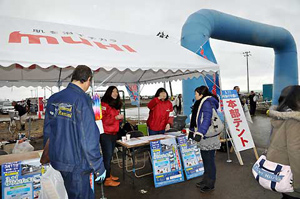 |
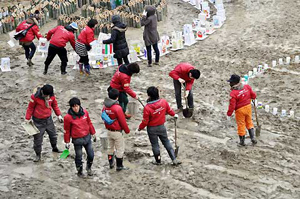 |
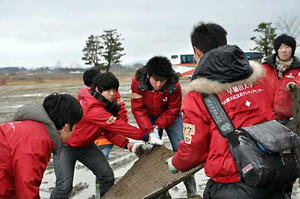 |
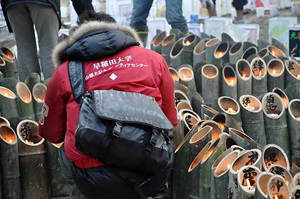 |
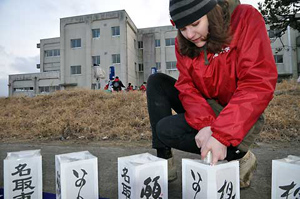 |
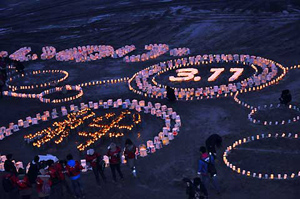 |
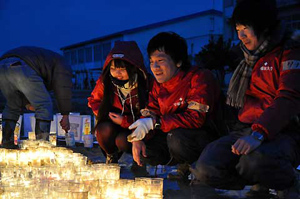 |
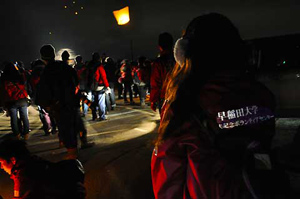 |
Kesennuma City ‘Light from March 11’
In the Light from March 11 event, 42 students and teachers (of these 37 were students) participated and provided operational support for the event.
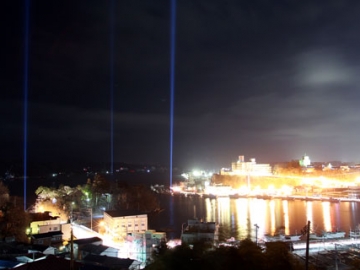 This event is a project of creating artificial light as the “light of mourning and hope” in places where people come together in an attempt to mourn the victims and in the disaster-hit areas where there are no monuments to prayer to. It is our hope “to come close to the feelings of people around the world, to become a monument on which is engraved the memory of the disaster and for the light to illuminate our future.” A pillar of light created by projection equipment stood for about six hours in the faint darkness of the sky after sunset in the inner bay of Kesennuma(Kanaegaura) which received a great deal of damage during the disaster. The night in Kesennuma was cold and it was also snowing, but the three beams of light in the perfectly clear night sky rose up perfectly straight.
This event is a project of creating artificial light as the “light of mourning and hope” in places where people come together in an attempt to mourn the victims and in the disaster-hit areas where there are no monuments to prayer to. It is our hope “to come close to the feelings of people around the world, to become a monument on which is engraved the memory of the disaster and for the light to illuminate our future.” A pillar of light created by projection equipment stood for about six hours in the faint darkness of the sky after sunset in the inner bay of Kesennuma(Kanaegaura) which received a great deal of damage during the disaster. The night in Kesennuma was cold and it was also snowing, but the three beams of light in the perfectly clear night sky rose up perfectly straight.
Kaho Kaneko, a second year student in the School of Law who participated as a volunteer said, “While I was working as security at the event, I exchanged words like ‘Thanks for your hard work’ and ‘Thank you’ with people and members in the local area. There were many times when I could really sense the warmth of the people. One of the local women who stared intently at the light praying left an impression on me. I felt strongly that the memories of the earthquake have been deeply etched in my heart and that this is something I will never forget. I would like to continue supporting this area in the future with recognition in myself that I am a concerned party in this.”
“The Hirayama Ikuo Volunteer Center (WAVOC) ” has dispatched more than 2,000 students and teachers to the disaster-hit areas since the Great East Japan Earthquake struck and these volunteers have performed a variety of activities in line with the needs of the local area. These activities include reconstruction support efforts (e.g. mud and debris removal) as well as sports, music and teaching programs. The disaster-hit areas are still in need of many people to help out. We hope to continue contributing to the recovery from the earthquake through our various support and volunteers efforts.” (WAVOC; All volunteer members)
Links
Hirayama Ikuo Volunteer Center (WAVOC) Great East Japan Earthquake Reconstruction Assistance Project


